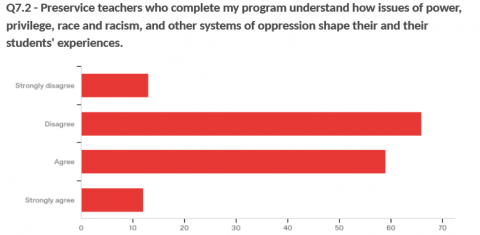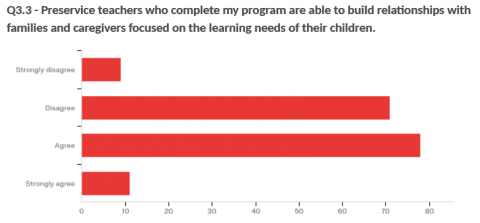To what degree are mathematics teacher candidates prepared to address issues of equity and social justice? Do our teacher education programs include features that promote equitable teaching? These are among the questions the AMTE Equity Committee sought to answer through a survey administered during Fall 2017.
Under the leadership of committee chair Marta Civil, members including Tonya Bartell, Erika Bullock, Ed Dickey, Anthony Fernandes, and Nicole Joseph used the AMTE Standards to design a survey and gather baseline information on the state of equity within mathematics teacher education programs. The 40-item survey--consisting of a mix of selected response and open-ended items--received 292 responses, though 169 were partial responses. About 90% of the respondents were AMTE members.
The AMTE Standards released in February 2017 include aspirational and explicit expectations for the education of well-prepared beginning teachers of mathematics. Figure 1 provides a list of how equity issues are addressed in the AMTE standards. Within the chapters addressing teacher candidate preparation, general standards appear in Chapter 2 as well as in the chapters focusing on different grade bands (Chapters 4-7). Within Chapter 3, which addresses mathematics teacher education programs, expectations for program characteristics are articulated. Chapter 8 elaborates on the assessment of candidates and programs to determine whether standards are met and inform program improvement.
Figure 1: Issues of Equity in AMTE Standards
Based on the AMTE Standards document, prompts for each of the survey items were drafted and piloted among 19 AMTE members in June of 2017. Items addressing the preparation of beginning teachers were addressed with 14 selected-response and 7 open-response items within seven sections titled: Equitable Teaching, Families and Communities, Access and Advancement, Mathematical Identities, Students’ Mathematical Strengths, Power and Privilege, and Ethical Practices for Advocacy. Program characteristics were addressed through 5 selected-response items and 1 open-response item. The final survey section gathered demographic information about respondents through 11 selected-response and 2 open-ended items. A summary of some of the demographic information gathered is provided in Figure 2. Other data gathered included ranges for program completers from Early Childhood, Elementary, Middle Level, and High School programs, as well as number of mathematics education faculty members.
Figure 2: Demographic Data on Survey Responders
At the February 2018 AMTE Conference, the Equity Committee presented the results of the survey and engaged attendees in a discussion of the findings and next steps to be taken. Key findings include quantitative data in Table 1 from Likert-scale items where 1 was assigned to Strongly Disagree, 2 to Disagree, 3 to Agree, and 4 to Strongly Agree. Each item statement in Table 1 began with the phrase: “Preservice teachers who complete my program are able to…”
|
|
ITEMS |
Mean |
SD |
|
2.2 |
Build on students' current mathematical ideas. |
3.09 |
0.64
|
|
2.3 |
Build on students' ways of knowing and learning by attending to developing students' identities and agency. |
2.74 |
0.64 |
|
2.4 |
Develop a sense of agency for making changes tied to equity and justice in schools. |
2.55 |
0.74 |
|
2.5 |
Foster growth mindsets about learning mathematics and counter fixed mindsets. |
3.05 |
0.59 |
|
3.2 |
Develop multiple strategies to get to know families and communities. |
2.57 |
0.72 |
|
3.3 |
Build relationships with families and caregivers. |
2.52 |
0.71 |
|
4.2 |
Know the meanings of access and advancement. |
2.56 |
0.73 |
|
5.2 |
Able to analyze their selection and implementation of tasks by reflecting on how these tasks may shape how students see themselves mathematically. |
2.70 |
0.69 |
|
5.3 |
Understand that how students' peers and teachers listen to and respect students' ideas affects their emerging mathematical identities. |
2.89 |
0.64 |
|
6.2 |
Value and notice students' prior/community knowledge and experiences. |
2.84 |
0.60 |
|
6.3 |
Draw upon students' prior/community knowledge and experiences to foster mathematics learning. |
2.64 |
0.67 |
|
6.4 |
Challenge deficit-based thinking about culturally and linguistically diverse students' learning. |
2.64 |
0.67 |
|
7.2 |
Understand how issues of power, privilege, race and racism, and other systems of oppression shape their and their students' experiences. |
2.41 |
0.76 |
|
8.2 |
Engage in ethical practices to advocate on behalf of their students. |
2.66 |
0.65 |
Table 1: Response Means and Standard Deviations (SD) on Items Addressing Beginning Teacher Preparation
As we can see from the results in Table 1, respondents appear to be somewhat more comfortable in preservice teachers' ability to foster growth mindsets and build on students’ current mathematical ideas. On the other hand, the items that referred to addressing issues of power, privilege, race and racism (item 7.2), agency (item 2.4), access and advancement (item 4.2), and relationships with families and caregivers (item 3.3) seemed to be more challenging and thus indicate areas where further attention in mathematics teacher preparation is needed. We discuss in more detail the two items (7.2 and 3.3) that had the lowest mean scores.
As summarized in Figure 3, more than half of respondents disagreed or strongly disagreed that their program completers understand issues of power, privilege, race or racism, or other systems of oppression that their students experience. Clearly this suggests an area for future work and attention by AMTE members. Open-responses indicated that attention to issues of power and privilege take place within courses that focus on multicultural and diversity issues. When addressed within mathematics education courses, the responses included some references to readings that are assigned but suggested that current efforts were lacking.

Figure 3: Responses to Item on Power, Privilege, Race or Racism and other Systems of Oppression
Similarly, another area for future work relates to building relationships with families. Figure 4 illustrates that slightly less than half of respondents disagreed or strongly disagreed that their program completers are able to address this expectation. Responses to a request for examples of how programs address this expectation included family math nights, field experiences that provide opportunities to participate in family events, interviews with community members, and states that require a course on working with parents. The committee observed that this expectation was not addressed at all institutions and that the work is often isolated from mathematics or mathematics education.

Figure 4: Responses to Item on Building Relationships with Families
Table 2 highlights responses addressing characteristics of programs tied to issues of equity. Each item statement in Table 2 began with the phrase: “My program includes features that embed opportunities for preservice teachers to…” From this the committee concluded that programs do embed opportunities to work with diverse students, to maintain high expectations for all, to model and discuss issues of diversity and culturally responsive mathematics instruction, and to build on students’ strengths, but acknowledged that embedding opportunities to recognize roles that identity and power play in mathematics education needs attention. Program features or activities that respondents cited as being effective in developing candidates’ ability to address equity, diversity, or social justice included field experiences in schools with different demographics, reflections, videos of preservice teacher-student interactions and interviews, readings related to equity and social justice, and community walks.
|
Item |
Mean |
SD |
|
Recognize the key roles identity and power play in mathematics education. |
2.52 |
0.71 |
|
Build on the multiple mathematical, cultural, linguistic, and family strengths that students bring to the classroom. |
2.74 |
0.72 |
|
Model and discuss inclusive and culturally responsive mathematics instruction. |
2.75 |
0.71 |
|
Work with culturally and linguistically diverse students. |
3.10 |
0.68 |
|
Demonstrate strategies for maintaining high expectations for each and every student. |
3.20 |
0.60 |
Table 2: Response Means and Standard Deviations on Items Addressing Mathematics Teacher Preparation Program Characteristics
The AMTE Equity Committee with its new members, Kathy Stoehr and Carlos LópezLeiva, will continue to examine the data and share ideas or resources with our membership to improve the preparation of beginning teachers in the areas of equity and social justice.
In conclusion, we encourage AMTE members to give particular attention to preparing beginning teachers to understand the role issues of power and privilege play with the teaching and learning of mathematics as well as how to help new teachers build relationships with the families and caregivers of the children they teach.
